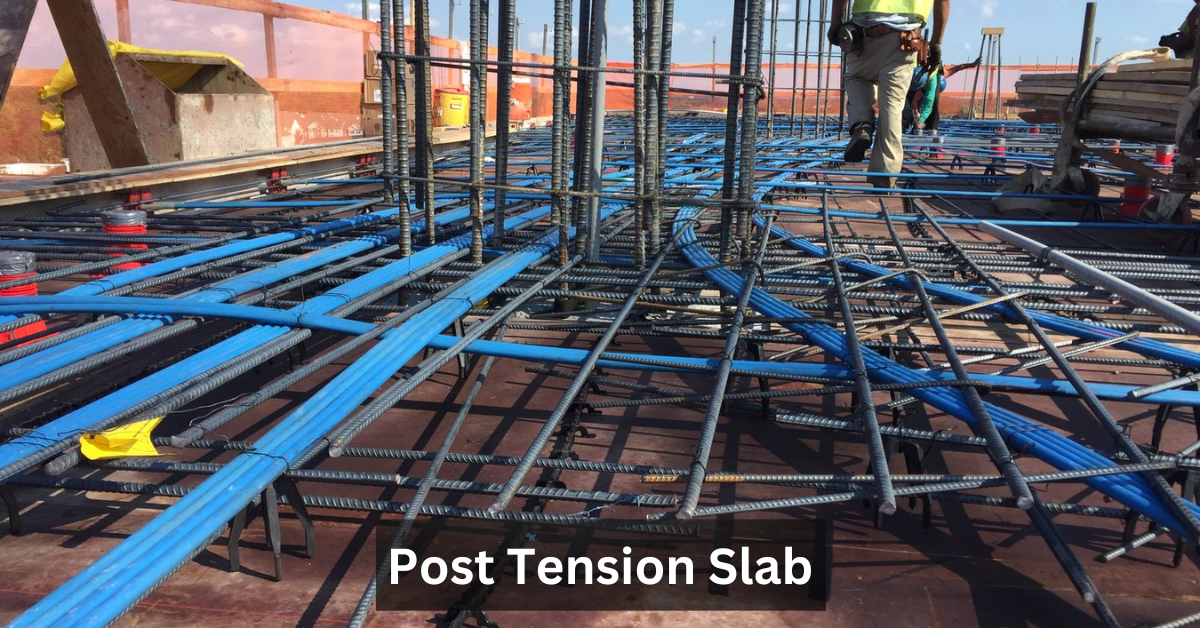Post tension slabs provide increased load-bearing capacity, thinner designs, column-free spaces, and enhanced durability with reduced maintenance requirements. By integrating post tensioning into modern building practices, construction professionals can achieve longer spans, thinner slabs, and increased durability—all while ensuring structural integrity and reducing maintenance needs. In this comprehensive guide, we will explore the core aspects of post tension slabs, from their foundational principles to their numerous applications across various types of construction projects.
What is a Post Tension Slab?
A post tension slab is a specialized type of reinforced concrete that utilizes high-strength steel tendons embedded within the slab. These tendons are stressed after the concrete has been poured and cured, transforming the way loads are distributed within the structure. Unlike traditional reinforced concrete, which relies heavily on steel rebar for tensile strength, post tension slabs combine the compressive strength of concrete with the tensile strength of steel to achieve superior structural performance. This allows for the construction of thinner slabs with greater load-bearing capacity and longer spans, making them ideal for modern architectural and engineering challenges.
Definition
The core concept of a post tension slab involves placing high-strength steel tendons within plastic or steel ducts that run throughout the slab. These tendons, coated with protective materials like polyethylene tape or grouting material, are then subjected to tension after the concrete reaches an appropriate level of strength. This process creates compressive forces in the concrete, counteracting tensile forces and reducing the likelihood of cracks and deformation. The result is a structure that exhibits enhanced durability, higher load capacities, and greater flexibility in design compared to conventional reinforced concrete.
Components of Post Tension Slabs
Tendons
At the heart of any post tension slab are high-strength steel tendons. These tendons are typically manufactured to meet stringent standards such as ASTM A-416, ensuring they provide maximum strength and durability. Depending on the project’s requirements, tendons may consist of single or multiple strands that offer a tensile strength far superior to conventional rebar. By incorporating these tendons, engineers are able to manage larger spans and distribute loads more evenly, resulting in more efficient structural designs.
Ducts
Ducts serve as protective enclosures for the tendons, preventing any contact between the steel and the concrete. Typically, ducts are made from materials such as metal or high-performance plastic, designed to be frictionless to allow smooth tendon movement during tensioning. After placement, these ducts are sealed using materials like polyethylene tape to ensure water-tightness and durability over time.
Anchors
Anchors are the termination points for the tendons. These devices ensure that the tension applied to the tendons is securely transferred into the concrete structure. Anchors come in various forms, including mechanical and resin-based anchors, designed to provide a strong, durable connection between the steel and the slab. Once tension is applied, anchors keep the system stable, maintaining the necessary forces throughout the life of the structure.
Working Principle of Post Tension Slab
The success of a post tension slab relies on its ability to effectively distribute loads and resist tensile forces. The process involves placing the tendons within ducts and then applying tension after the concrete has set. This method creates a compressive force that counteracts the natural tension forces within the slab caused by heavy loads. Let’s explore how this process works in greater detail.
How Post Tensioning Works
When a typical concrete slab is subjected to heavy loads, such as furniture, equipment, or even the weight of the building itself, it experiences tensile stresses. Over time, these stresses can lead to cracking and structural deformation. Post tensioning combats this by inserting tendons into the slab, which are then stressed to create compressive forces. This results in a balance where the slab remains stable and resilient to cracking, even under significant loads.
Benefits of Combining Concrete and Steel
The synergy between concrete and steel in post tension slabs creates a system where both materials complement each other’s strengths. Concrete, with its high compressive strength, works to resist crushing forces, while steel tendons provide the necessary tensile support. Together, they create a balanced structure that can handle complex loads and adapt to dynamic environmental factors. This combination allows post tension slabs to offer numerous benefits over traditional reinforced concrete, particularly in terms of durability, flexibility, and efficiency.
Benefits of Post Tension Slabs
Post tension slabs are rapidly becoming the go-to choice for many modern construction projects due to their exceptional benefits. From enhanced architectural freedom to significant cost savings, these slabs are designed to meet the demands of today’s dynamic building environments. Let’s dive deeper into some of the key advantages that post tension slabs provide.
Architectural Flexibility
One of the most notable benefits of post tension slabs is their ability to create expansive, column-free spaces. Traditional reinforced concrete often necessitates the use of support columns to bear heavy loads, which can limit design possibilities. However, post tension slabs eliminate this need, allowing architects and designers to create open, flexible spaces that are visually appealing and functional. Whether it’s large retail spaces, office complexes, or residential buildings, the flexibility provided by post tension slabs allows for creative and innovative design solutions.
Increased Load-Bearing Capacity
Post tension slabs are engineered to withstand significant loads with minimal deflection. This increased load-bearing capacity is particularly beneficial for high-rise buildings and structures that need to endure heavy live and dead loads. The high-strength steel tendons absorb tensile stresses effectively, preventing the slab from cracking or deforming under pressure. This feature ensures that the structure remains safe and stable throughout its lifespan.
Thinner Slabs and Column-Free Spaces
Another significant advantage of post tension slabs is the ability to design thinner slabs without compromising strength. By incorporating high-strength tendons, slabs can be designed to be up to 30% thinner than conventional concrete, which translates into cost savings on materials and labor. Additionally, the absence of intermediate columns leads to open, uninterrupted spaces, enhancing both functionality and aesthetics in various applications.
Types of Post Tension Slabs
Post tension slabs come in various configurations, each tailored to meet specific structural and architectural needs. Let’s explore the different types and their unique characteristics.
Flat Slab
Flat slabs are a popular choice for low to medium-rise buildings. They provide a seamless, column-free ceiling, making them ideal for spaces that require flexibility and minimal obstruction. By eliminating beams and traditional drop panels, flat slabs offer cost-effective solutions for residential and commercial spaces alike.
Ribbed Slab
Ribbed slabs are designed to handle heavier loads with an intricate grid of ribs embedded within the slab. These ribs distribute loads more effectively, making them suitable for industrial buildings and structures with increased load requirements. Ribbed slabs provide a robust foundation while maintaining an aesthetic appeal.
Waffle Slab
Waffle slabs are renowned for their superior load distribution and reduced material usage. They feature a grid of voids, offering a lightweight yet durable solution for a variety of building applications. This makes waffle slabs perfect for large-span constructions where weight reduction is essential without compromising structural integrity.
Construction Process of Post Tension Slabs
The construction of post tension slabs involves a series of precise steps that must be meticulously planned and executed to ensure optimal performance. Let’s walk through the essential stages of this process.
Preparation and Planning
Before construction begins, thorough preparation is necessary. This includes designing the slab’s layout, determining tendon placement, and choosing the appropriate anchoring system. Engineers collaborate with civil and structural teams to ensure that all design and load requirements are met.
Placement of Tendons and Reinforcement
Once the design phase is complete, tendons are carefully positioned within ducts. The alignment of these tendons is critical to maintaining the overall structural balance. In addition, traditional rebar is used where additional support is required to enhance the slab’s overall integrity.
Concrete Pouring and Tensioning Process
After reinforcement placement, the concrete is poured and allowed to cure. Once the concrete achieves sufficient strength, typically around 20-23 days, the tendons are tensioned using high-precision hydraulic jacks. This tensioning process creates the necessary compressive force to balance the slab’s tensile stresses.
Post-Tensioning Steps and Techniques
Following the tensioning process, anchors are installed to secure the tendons in place. This ensures that the applied tension is maintained over the slab’s lifespan, creating a stable and durable structure. Proper grouting and sealing techniques are then used to encapsulate the tendons, providing long-term protection.
Materials Used in Post Tension Slabs
The materials utilized in post tension slabs are carefully selected to guarantee structural efficiency and durability. High-quality components are essential for maintaining the performance of these advanced systems.
High-Strength Steel Tendons
High-strength steel tendons, manufactured to ASTM standards, are the primary component in post tension slabs. These tendons are capable of withstanding extreme loads and resist deterioration due to their protective coatings.
Ducts and Anchorage Systems
Ducts protect the tendons from the harsh environment of the concrete, ensuring they remain frictionless and free from corrosion. Anchorage systems, whether mechanical or resin-based, securely anchor the tendons into the concrete structure for long-term stability.
Concrete Specifications and Additives
Concrete used in post tension slabs incorporates admixtures to improve strength, durability, and resistance to environmental stresses. These additives enhance the slab’s overall performance, ensuring minimal cracking and high longevity.
Challenges and Considerations
While post tension slabs offer numerous benefits, they do require careful consideration and planning to ensure optimal performance. Let’s explore some of the challenges and considerations involved in their construction.
Potential Risks and Limitations
One of the primary risks associated with post tension slabs is the need for highly skilled labor and precise execution. The tensioning process requires trained professionals who can accurately apply the correct amount of stress to the tendons. Mismanagement during this phase can lead to uneven stress distribution, causing structural instability and potential cracks. Additionally, since the tendons are hidden within ducts, regular inspection and maintenance are essential to ensure the long-term durability of the structure.
Maintenance and Inspection Requirements
Periodic inspections are critical for post tension slabs to monitor the integrity of tendons, anchors, and the concrete itself. Over time, environmental factors such as temperature fluctuations, exposure to moisture, and chemical reactions can affect the durability of the materials. Regular maintenance ensures that any early signs of distress, such as micro-cracks or rusting in steel tendons, are promptly addressed to prevent more serious issues.
Applications of Post Tension Slabs
Post tension slabs are widely used across a variety of construction projects due to their versatility and performance. From residential homes to complex commercial and industrial structures, these slabs offer unmatched benefits for both design and functionality.
Residential Buildings
In residential construction, post tension slabs are increasingly being used to create expansive floor areas with minimal internal support. Homebuilders and architects appreciate the flexibility these slabs provide, allowing for open-plan layouts and larger living spaces that cater to modern lifestyle needs. Additionally, the thinner design leads to reduced overall building height, maximizing the usable space within the same footprint.
Commercial Spaces
Commercial buildings benefit from the load-bearing capacity of post tension slabs. These slabs support heavy equipment, furnishings, and foot traffic, ensuring the safety and durability required for businesses to thrive. Office buildings, shopping centers, and recreational facilities are just some of the spaces where post tension slabs are employed to optimize structural performance.
Industrial and Infrastructure Projects
For industrial facilities and infrastructure projects, such as bridges and airport terminals, post tension slabs provide the necessary strength and durability to handle dynamic loads and environmental stresses. These structures often need to endure extreme conditions, making the added resilience of post tension systems a practical solution.
Cost-Effectiveness and Efficiency
One of the standout advantages of post tension slabs is their cost-effectiveness and efficiency compared to traditional construction methods. By reducing the need for thicker concrete and minimizing the use of support columns, these slabs lead to significant savings in material costs, labor, and overall construction time.
Cost Savings with Thinner Slabs
Thinner post tension slabs require less concrete and reinforcement, translating into substantial savings. Additionally, the reduction in floor-to-floor heights allows for more floors to be built within the same overall building height, creating additional revenue-generating space in commercial developments.
Reduced Construction Time and Resources
The streamlined process of post tension construction speeds up the timeline from design to completion. With fewer materials and shorter construction phases, developers can achieve quicker project delivery without compromising structural integrity.
Long-Term Durability and Reduced Maintenance
Beyond initial cost savings, post tension slabs offer long-term durability. The tensioning process improves crack resistance, reducing the need for ongoing maintenance. Structures built with post tension slabs have been proven to endure environmental challenges and high loads, ensuring sustained performance over decades.
Future Trends and Innovations
The field of post tension slabs continues to evolve with advancements in materials, technology, and construction techniques. Innovations are driving increased sustainability, faster construction methods, and improved structural performance.
Advances in Post-Tensioning Technology
New technologies in stress monitoring, automated tensioning systems, and advanced materials are enhancing the efficiency and precision of post tension slabs. These advancements allow for more accurate load distribution, minimizing the risk of structural failure.
Sustainability in Post Tension Slab Construction
With the growing focus on sustainable building practices, post tension slabs are increasingly being designed with eco-friendly materials and processes. By optimizing material usage and reducing waste, these systems contribute to greener, more environmentally-conscious construction projects.
Conclusion
Post tension slabs have revolutionized modern construction, offering a perfect blend of strength, efficiency, and design flexibility. By integrating high-strength steel tendons and advanced engineering techniques, they provide a reliable solution for a wide range of structural applications. From residential homes to commercial skyscrapers and industrial facilities, the advantages of post tension slabs are undeniable. With continued innovations and a commitment to excellence, post tension slabs will remain at the forefront of contemporary construction practices for years to come.
Frequently Asked Questions
How is a post tension slab constructed?
The construction involves placing tendons along with conventional rebars, encasing them in ducts, and stressing the tendons after concrete has set. This process helps compress the concrete, improving its strength.
What materials are used in post tension slabs?
High-strength steel tendons, durable ducts, anchors, and concrete with specific admixtures are used to construct post tension slabs.
Are there any challenges with post tension slabs?
Yes, post tension slabs require skilled labor for the tensioning process and regular inspections to ensure structural integrity and prevent issues like cracking or tendon failure.
Stay in touch to get more updates & alerts on WashingtonGreek! Thank you


